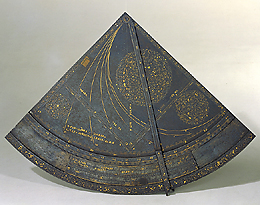
 |
| Catalogue |
 |
 Quadrant Face 2: The limb is decorated by six alternating, separated, sections of flowing leaf decoration and linked lozenges, each section occupying approximately 15? of the arc. Above this is a 360? scale reading to 1? by alternately hatched and unhatched divisions in four concentric arcs. Above this is a further arc of flowing leaf decoration and above this is the diagram of an horizontal quadrant, that is a stereographic projection of the celestial co-ordinates onto the plane of the observer's horizon. The diagram is in effect that found on an astrolabe plate, with the addition of the path of the ecliptic, when this is twice folded on itself to produce a quadrant. The right hand edge of the quadrant represents the meridian, the left hand edge the horizon, both being so labelled in Latin. The almucantars are drawn as arcs across the instrument for every 2( and numbered in groups of 10, 0 to 90 (equator) to 60. The two arcs of the ecliptic are drawn with the names and symbols of the signs, each sign divided to 30?, and the arc for the equinoctial is also divided to 90?. A segment of the tropic of Cancer arc is drawn below the apex and the names and positions of stars are marked. Those that can now be read are: 'Cor scorpii', 'Canis maior', 'Oculus tauri', 'Venter ceti', 'Spica', 'Caput serpentarii', 'Lucia hydr?e', 'Canis minor', 'Dexter humerus Orioni', 'Corona serpentarii', 'Vulur cadens', 'Lanx meridi', 'Lanceator', 'Hircu', 'Dexter La Perseiu', 'Caput Algol', 'Dorsum', 'Cauda' 'Umbilicus Andro{meda}'. A rule graduated with a reversed 90? scale (portion nearest the apex), and a 231/2? obliquity scale is pivoted at the apex/centre of the instrument. Anthony J. Turner |



